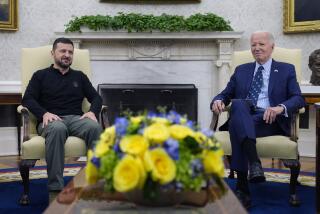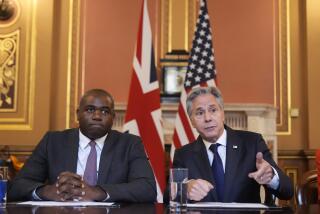Allies Face Own Weapons: ‘Today’s Friend, Tomorrow’s Enemy’ : Middle East: Arab arsenals are a caldron of foreign-made arms. Diplomats say the deals are out of control.
EASTERN SAUDI ARABIA — American pilots dodging missiles and antiaircraft fire in the skies over Iraq and Kuwait are learning a distressing reality of the Middle East: Some of the weapons endangering their lives were made by allies, and a few were even manufactured in the United States.
It is a lesson that other fighting forces have learned over the years in a region whose per capita military spending is three times the world average. The huge expenditures have turned the Middle East into the world’s largest arms bazaar; from every corner of the world where killing tools are made, Arab nations have built up their arsenals with little regard for the country of origin.
Iraq has bought missiles from China and France, warships and mines from Italy, fighter-bomber jets from the Soviet Union and France, artillery from South Africa and the Soviet Union--and it has Stinger missiles and other U.S. weapons captured from Kuwait.
Just to add to the caldron of confusion, Iraq on Aug. 1 also had nonaggression pacts with two nations it is now at war with, Saudi Arabia and Bahrain, and a friendship treaty with a third that has turned against Baghdad, the Soviet Union.
“We’re going up against a lot of our own systems,” said Marine Col. W. C. McMullen, an F/A-18 pilot and leader of the “Death Angels” squadron. “Today’s friend could be tomorrow’s enemy. Countries of the world need to be a little more discreet about who they sell weapons to, and that includes us.”
Although pilots often single out France for selling weapons to whoever has a checkbook, many nations are culpable. During the Iran-Iraq War, for instance, 26 nations, including the United States, France and the Soviet Union, provided weapons to both sides in the eight-year conflict. It was a war that much of the international community hoped Iran and Iraq both would lose.
The Middle East arms race, which both Western and Arab diplomats consider to be clearly out of control, has its roots in the Arab-Israel dispute as well as in intra-Arab rivalry. Competing forces said they wanted military parity with their adversaries, while striving for military superiority.
With the world’s arms merchants willing to service all bidders, the Middle East--with its oil revenues and willingness to forgo other spending priorities--has, in the past four decades, fought more wars and suffered more casualties than any region in the world.
The Middle East, with less than 3% of the world’s population, accounts for more than 8% of the world’s military spending. Governments here spend in excess of $350 annually per person--three times the world average--for military purposes, the International Peace Research Institute in Stockholm has reported.
According to another study, prepared by Anthony H. Cordesman, vice president of the Eastern Analytical Assessments Center, Middle East countries accounted for 42% of the world’s arms imports in 1983.
Between 1979 and 1986, Cordesman estimates, 3.5 million people were casualties of various conflicts. The Iran-Iraq War, which ended in 1988, alone claimed 1 million casualties; in the Gulf War, Iraqi President Saddam Hussein has shown an apparent willingness to sacrifice as many of his people as necessary to make some ill-defined political point.
Defense spending in the tiny United Arab Emirates, with its $1.6-billion military budget, increased 56-fold in the decade just ended; Oman has devoted up to 40% of its budget to defense. Egypt had more men in uniform in 1991 (450,000) than it did in 1979 (350,000), when it signed a peace treaty with Israel. Egypt has another 1.2 million in the reserves.
Despite the U.N. embargo placed on Iraq, law enforcement and intelligence agencies in the United States have detected more than 700 cases, in which firms and individuals worldwide have attempted to sell munitions and other goods to the Baghdad government, U.S. sources told The Times last month.
Iraq, with a U.S.-estimated $50 billion in military spending, is reliably reported to have tried to buy 100 mobile Scud missile launchers that Iran bought from North Korea in the 1980s. Even as they pledged to support the embargo against Iraq, Chinese leaders were searching for ways to smuggle weapons to Iraq earlier this year, the Christian Science Monitor has reported.
Any country needing 24 Soviet-made Scud missiles can contact Hungary, which has just put the weapons on the market. (This, even though Hungarian law says the weapons cannot be sold to a country fighting a war.)
There has been widespread speculation that once the Gulf War ends, the superpowers will take the lead in imposing a limitation on arms sales to Middle East countries, including Israel.
But as American pilots fly through shields of antiaircraft fire, most are skeptical about the world’s ability or willingness to limit the sale of arms.
“I don’t think there is any way to check it,” said Air Force Capt. Linden Sims, an RF-4C pilot. “There’s always countries out there selling arms. There’s always going to be a threat, either with our equipment or somebody else’s.”
This article was written in part from correspondent pool reports cleared by U.S. military authorities.
More to Read
Sign up for Essential California
The most important California stories and recommendations in your inbox every morning.
You may occasionally receive promotional content from the Los Angeles Times.










